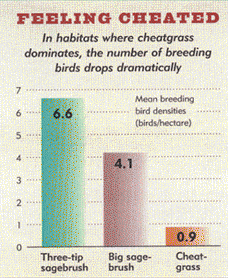What impacts on watersheds also affect birds?
Another major factor reducing the quality of native bird habitats is the introduction of invasive and non-native plant and animal species. People have brought thousands of species to North America from other parts of the world, and we continue to do so at an increasing rate. Some of these species become severe stresses in watersheds and some particularly affect birds. The Fish and Wildlife Service estimates that non-native, invasive species destroy approximately 4600 acres of indigenous habitat per day and researchers estimate that non-native species cause over $136 billion of damage every year.
A particularly
destructive non-native predator of birds is the domestic cat, particularly those that
become wild in natural areas. There are over 100 million feral and domestic cats in the
U.S. A study of cat predation on birds in Wisconsin showed that, in that state alone,
cats were estimated to kill on the order of 39 million birds per year. The American Bird
Conservancy's Cats Indoors
![]() site provides more information on the damage cats do
each year to the bird population.
site provides more information on the damage cats do
each year to the bird population.
![[logo] US EPA](https://www.epa.gov/epafiles/images/logo_epaseal.gif)
